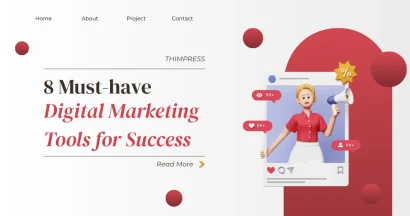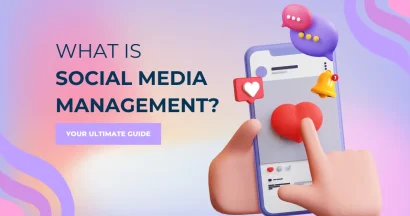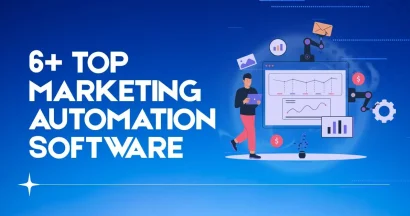The AIDA Model was introduced in the late 1800s by American businessman Elias St. Elmo Lewis. It outlines the 4 key stages a customer goes through before making a purchase.
Even today, marketers around the world still rely on AIDA to plan successful marketing strategies.
So, what makes AIDA so powerful and long-lasting? Let’s dive in.
What Is the AIDA Model?
AIDA stands for:
- Awareness
- Interest
- Desire
- Action
These four stages reflect how customers think and behave when they’re deciding whether to buy something.
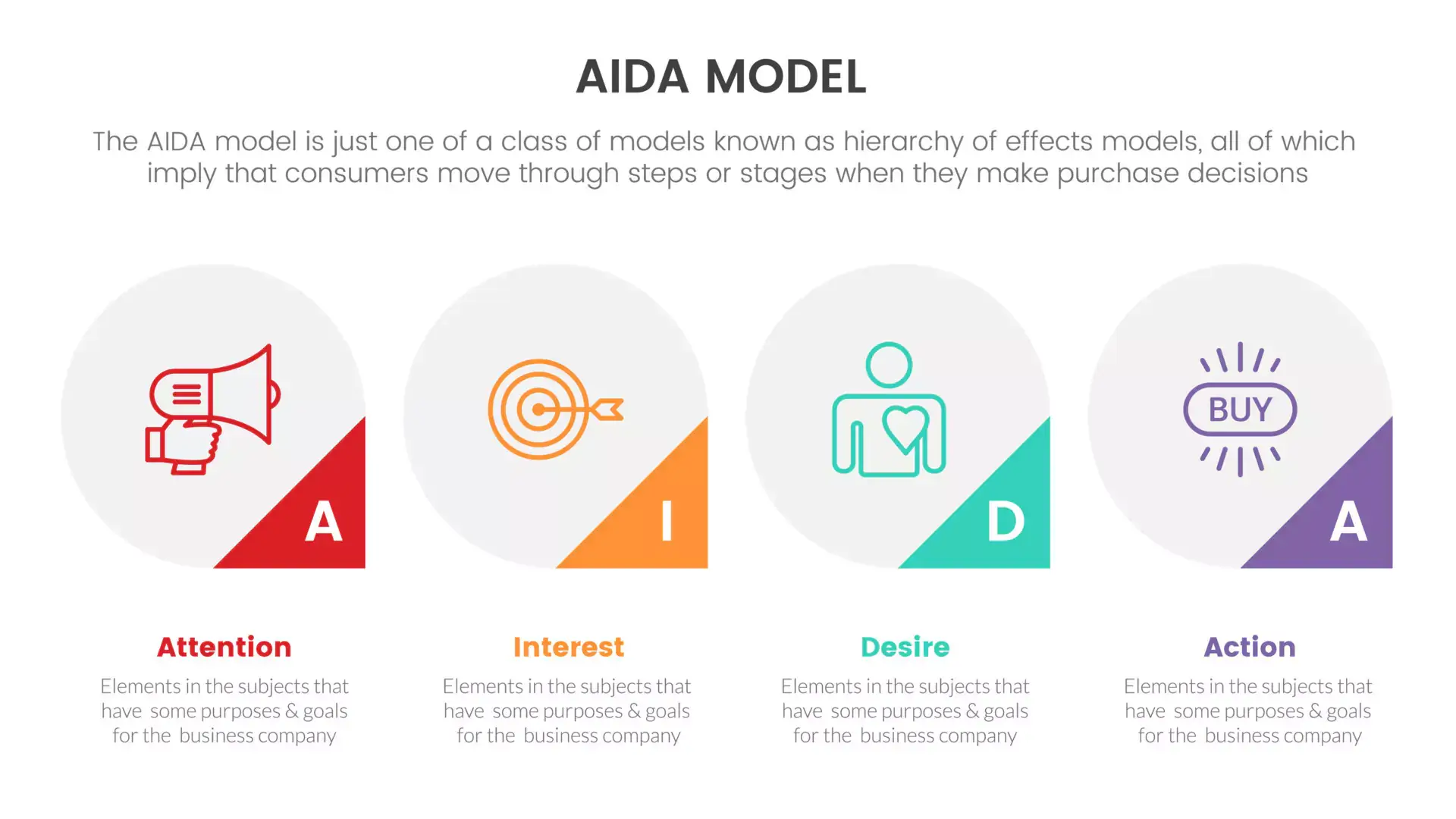
Here’s what each stage means:
- Awareness: Grab attention and let people know your product or service exists.
- Interest: Keep them curious—show benefits and provide useful info.
- Desire: Help them connect emotionally. Move them from “I like it” to “I want it.”
- Action: Get them to act—sign up, buy, or take the next step.
What Is The AIDA Model Used For?
The AIDA model is used in marketing to guide the customer journey from discovering a product to making a purchase. It helps businesses attract attention, build interest, create desire, and drive customers to take action.
How Do You Use The AIDA Model in Marketing?
You can use AIDA by first grabbing attention with bold ads or headlines, then offering useful info to spark interest. Show benefits to create desire, and finally, use strong calls-to-action like “Buy now” or “Sign up” to drive sales.
What Are The 4 Steps of The AIDA Model?
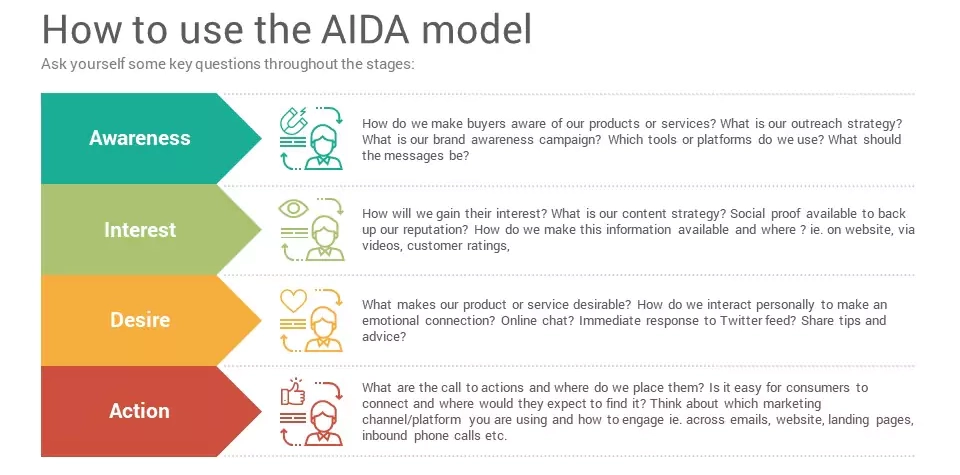
You can find out some focusing questions based on each stage of the AIDA model:
- Awareness: What is your outreach strategy? How will you increase the audience’s awareness about your services or products? Which campaign will you conduct? Which platforms and widgets will you use? What will the messages or slogans be?
- Interest: How will you gain interest? What is your content plan? What are the available social proofs to back up the reputation in case anything goes wrong? How and where will you deliver this information to the audience?
- Desire: What will shine on your products or services? How do we interact with the customers to make emotional connections? How will you handle the online chat? Or handling the responses on social media channels?
- Action: What are your call-to-action buttons? Where will you place ’em? Is it easy for customers to connect and where to find it? How will you engage in AIDA marketing?
Attract Attention
To approach customers in the AIDA Model you need to make them aware of the product or service that exists. We do suggest you use one of these content types such as advertising, making videos, using podcasts, and social media at this stage.
Then, we will attract customers’ attention by creating disruption in some of these ways. However, do not be too disruptive. You need to determine between clever or annoying to avoid the fine line:
- Using bold colors to impress customers
- Placing provocative images in unexpected ways
- Making a sensational and entertaining video
- Adding a provocative graphic on a landing page.
- Using music that evokes nostalgia.
Maintain Interest
This step seems like the hardest part of the AIDA Model. We suggest you use web content, newsletters, blogs, and email campaigns to keep them engaged. Remember that all the advertising information should be easy to read, with interesting videos, funny & clear content by subheads or suitable music.
Moreover, list out the important messages that you wish customers to know and of course, it should be relative to your product or service.
Create Desire
After building your customer’s interest, you might persuade them and then let them need your product because it is truly useful and helpful.
At this stage of the AIDA model, you should make a comparison of the benefits of buying and why it is different from others. You can stress some main features in this part but do not do too much.
Take Action
After attracting attention, maintaining interest, and creating desire, the last step of the AIDA Model is to motivate clients to initiate action. This requires customers to immediately respond to purchase the product or create an account or sign up for a free trial or more.
AIDA Model Modifications
These are some modifications of the AIDA Model:
- Retention: You will get upsells or more sales by retention. However, the original AIDA Model did not have this after purchase. Sometimes, some marketers added the letter “R” into the AIDA Model to become the AIDAR model. It is to show how important retention is.
- Targeting: When customers interact with search engines on the internet, you will collect their interests and then target ads.
- Conviction: To avoid doubting our customers, you can give them free tests, free trials, free samples, and so on.
- Satisfaction: Additionally, leveraging AI communication in your business strategy can revolutionize how you interact with customers. AI-driven chatbots and virtual assistants can offer 24/7 support, answering queries and providing assistance, which significantly boosts customer engagement and satisfaction.
Example of The AIDA Model in Marketing
You may wonder “Why is AIDA model important”. Here’s an instance of how a business might employ the AIDA model:
Example 1: A billboard for a new smartphone using the AIDA model
- Attention: The billboard is large and colorful, with a bright image of the new smartphone. The headline is eye-catching and says “The next generation of smartphones is here.”
- Interest: The billboard copy highlights the key features of the new smartphone, such as its powerful processor, high-resolution camera, and long-lasting battery. It also mentions that the phone is available in a variety of colors.
- Desire: The billboard creates a sense of desire for the new smartphone by showing people how it can make their lives better. For example, it shows how the phone can be used to take stunning photos, play games, and stay connected with friends and family.
- Action: The billboard tells people where they can go to learn more about the new smartphone and buy it. It also includes a call to action, such as “Visit our website or call us today.”
Example 2: A social media ad for a new pair of sneakers using AIDA model
- Attention: The social media ad is eye-catching and features a high-quality image of the new pair of sneakers. The headline is short and to the point, and says “The sneakers you’ve been waiting for.”
- Interest: The ad copy talks about the benefits of the new sneakers, such as their comfort, style, and performance. It also mentions that the sneakers are available in a variety of sizes and colors.
- Desire: The ad creates a sense of desire for the new sneakers by showing people how they can look and feel their best when wearing them. For example, it shows how sneakers can be used to elevate any outfit and make a statement.
- Action: The ad tells people where they can go to buy the new sneakers. It also includes a call to action, such as “Shop now” or “Buy yours today.”
Example 3: A billboard for a juicy hamburger using the AIDA model
- Attention: A fast food restaurant might use a large billboard with a picture of a juicy hamburger to capture attention.
- Interest: The fast food restaurant might include a description of the hamburger on the billboard, such as “Made with 100% beef, fresh lettuce, and juicy tomatoes.”
- Desire: The fast food restaurant might show a picture of a person enjoying the hamburger on the billboard, or they might include a tagline that says “The best hamburger in town!”
- Action: The fast food restaurant might include a coupon for the hamburger on the billboard, or they might include a map to their nearest location.
Example 4: A company that sells weight loss supplements using AIDA model
- Attention: The ad could start with a shocking statistic about the number of people who are overweight or obese.
- Interest: The ad could then talk about the benefits of using the weight loss supplement, such as how it can help people lose weight, improve their health, and boost their confidence.
- Desire: The ad could then use testimonials from people who have lost weight using the supplement to show that it really works.
- Action: The ad could end with a call to action that encourages people to visit the company’s website or call a toll-free number to learn more about the supplement.
Test Your AIDA Knowledge – Quick Quiz!
Want to see how well you’ve understood the AIDA model? Take this short quiz and find out!
b) Awareness, Interest, Desire, Action
c) Attract, Involve, Deal, Ask
d) Awareness, Influence, Direction, Activity
b) Make people want your product
c) Get feedback from users
d) Collect emails for newsletters
b) Sending an email
c) A customer clicking “Buy Now”
d) Writing a blog post
Real Case Study: How Nike Used AIDA to Launch a Sneaker
Let’s look at a real-world example of the AIDA model in action. Nike often uses this model when launching new products. Here’s a breakdown of how it worked for one of their popular sneaker drops:
Attention:
Nike created buzz through teaser videos, social media posts, and influencer shoutouts before the launch. These ads featured bold visuals and powerful headlines like “Power Up Your Stride.”
Interest:
They shared behind-the-scenes videos of the design process and interviews with athletes who wear the shoes. These stories helped build interest and make people curious.
Desire:
Next, Nike showed how the sneakers helped athletes run faster and jump higher. Real testimonials and performance comparisons made people want the shoes—not just like them.
Action:
Finally, Nike added strong CTAs like “Shop Now,” “Limited Stock Available,” and even countdown timers to create urgency. Within hours of launch, the sneakers sold out online.
Final Thoughts
Understanding what AIDA strategy is, will absolutely help you to attract the attention of customers, generate their interest, create their desire, and call to action in AIDA marketing.
We do hope that you enjoy our topic today and helps you have a new marketing strategy to grab potential buyers.
You might be interested in these other related topics, such as:
- 10+ Famous Marketing Models That Will Transform Your Strategy
- SWOT Analysis: A Complete Guide to Evaluating Your Business (With Examples)
- 7Ps of Marketing: What Are They and How To Use Theme?
- What is 4P in Marketing?
Contact US | ThimPress:
Website: https://thimpress.com/
Fanpage: https://www.facebook.com/ThimPress
YouTube: https://www.youtube.com/c/ThimPressDesign
Twitter (X): https://twitter.com/thimpress
